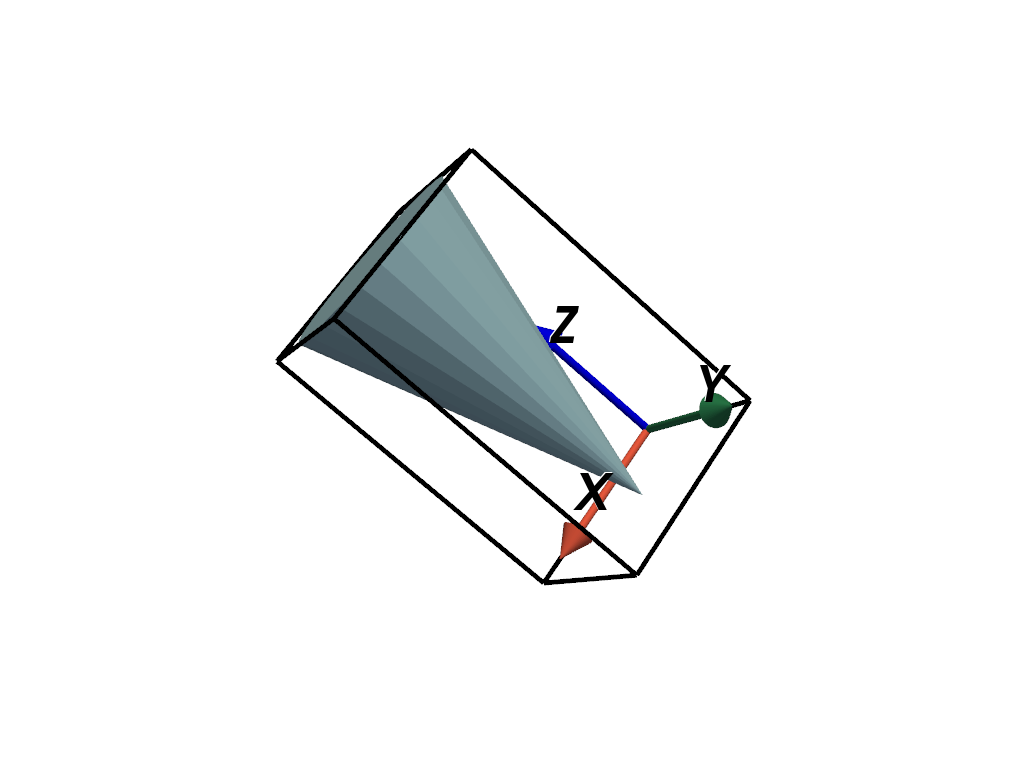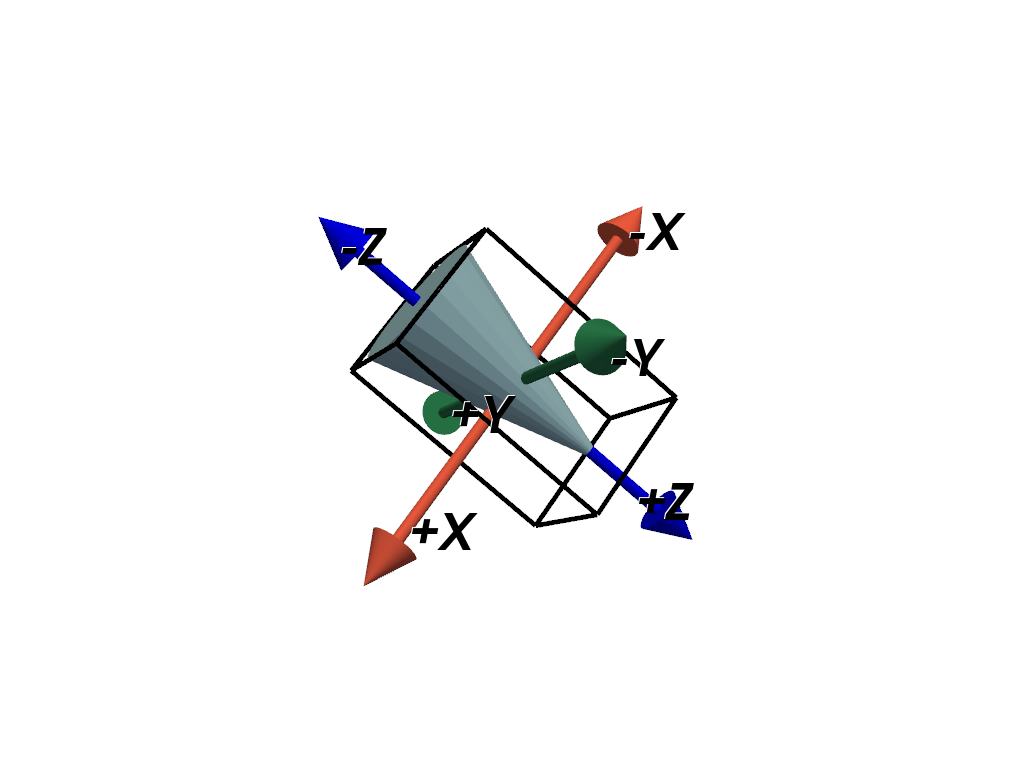pyvista.DataSetFilters.oriented_bounding_box#
- DataSetFilters.oriented_bounding_box(
- box_style: Literal['frame', 'outline', 'face'] = 'face',
- *,
- axis_0_direction: VectorLike[float] | str | None = None,
- axis_1_direction: VectorLike[float] | str | None = None,
- axis_2_direction: VectorLike[float] | str | None = None,
- frame_width: float = 0.1,
- return_meta: bool = False,
- as_composite: bool = True,
Return an oriented bounding box (OBB) for this dataset.
By default, the bounding box is a
MultiBlockwith sixPolyDatacomprising the faces of a cube. The blocks are named and ordered as('+X','-X','+Y','-Y','+Z','-Z').The box can optionally be styled as an outline or frame.
Note
The names of the blocks of the returned
MultiBlockcorrespond to the oriented box’s local axes, not the global x-y-z axes. E.g. the normal of the'+X'face of the returned box has the same direction as the box’s primary axis, and is not necessarily pointing in the +x direction(1, 0, 0).Added in version 0.45.
- Parameters:
- box_style‘frame’ | ‘outline’ | ‘face’, default: ‘face’
Choose the style of the box. If
'face'(default), each face of the box is a single quad cell. If'outline', the edges of each face are returned as line cells. If'frame', the center portion of each face is removed to create a picture-frame style border with each face having four quads (one for each side of the frame). Useframe_widthto control the size of the frame.- axis_0_direction
VectorLike[float] |str,optional Approximate direction vector of this mesh’s primary axis. If set, the first axis in the returned
axesmetadata is flipped such that it best aligns with the specified vector. Can be a vector or string specifying the axis by name (e.g.'x'or'-x', etc.).- axis_1_direction
VectorLike[float] |str,optional Approximate direction vector of this mesh’s secondary axis. If set, the second axis in the returned
axesmetadata is flipped such that it best aligns with the specified vector. Can be a vector or string specifying the axis by name (e.g.'x'or'-x', etc.).- axis_2_direction
VectorLike[float] |str,optional Approximate direction vector of this mesh’s third axis. If set, the third axis in the returned
axesmetadata is flipped such that it best aligns with the specified vector. Can be a vector or string specifying the axis by name (e.g.'x'or'-x', etc.).- frame_width
float,optional Set the width of the frame. Only has an effect if
box_styleis'frame'. Values must be between0.0(minimal frame) and1.0(large frame). The frame is scaled to ensure it has a constant width.- return_metabool, default:
False If
True, also returns the corner point and the three axes vectors defining the orientation of the box. The sign of the axes vectors can be controlled using theaxis_#_directionarguments.- as_compositebool, default:
True Return the box as a
pyvista.MultiBlockwith six blocks: one for each face. Set thisFalseto merge the output and returnPolyData.
- Returns:
pyvista.MultiBlockorpyvista.PolyDataMultiBlock with six named cube faces when
as_composite=Trueand PolyData otherwise.numpy.ndarrayThe box’s corner point corresponding to the origin of its axes if
return_meta=True.numpy.ndarrayThe box’s orthonormal axes vectors if
return_meta=True.
See also
bounding_boxSimilar filter for an axis-aligned bounding box (AABB).
align_xyzAlign a mesh to the world x-y-z axes. Used internally by this filter.
pyvista.Plotter.add_bounding_boxAdd a bounding box to a scene.
pyvista.CubeFacesSourceGenerate the faces of a cube. Used internally by this filter.
Examples
Create a bounding box for a dataset.
>>> import pyvista as pv >>> from pyvista import examples >>> mesh = examples.download_oblique_cone() >>> box = mesh.oriented_bounding_box()
Plot the mesh and its bounding box.
>>> pl = pv.Plotter() >>> _ = pl.add_mesh(mesh, color='red') >>> _ = pl.add_mesh(box, opacity=0.5) >>> pl.show()

Return the metadata for the box.
>>> box, point, axes = mesh.oriented_bounding_box('outline', return_meta=True)
Use the metadata to plot the box’s axes using
AxesAssembly. The assembly is aligned with the x-y-z axes and positioned at the origin by default. Create a transformation to scale, then rotate, then translate the assembly to the corner point of the box. The transpose of the axes is used as an inverted rotation matrix.>>> scale = box.length / 4 >>> transform = pv.Transform().scale(scale).rotate(axes.T).translate(point) >>> axes_assembly = pv.AxesAssembly(user_matrix=transform.matrix)
Plot the box and the axes.
>>> pl = pv.Plotter() >>> _ = pl.add_mesh(mesh) >>> _ = pl.add_mesh(box, color='black', line_width=5) >>> _ = pl.add_actor(axes_assembly) >>> pl.show()

Note how the box’s z-axis is pointing from the cone’s tip to its base. If we want to flip this axis, we can “seed” its direction as the
'-z'direction.>>> box, _, axes = mesh.oriented_bounding_box( ... 'outline', axis_2_direction='-z', return_meta=True ... ) >>>
Plot the box and axes again. This time, use
AxesAssemblySymmetricand position the axes in the center of the box.>>> center = pv.merge(box).points.mean(axis=0) >>> scale = box.length / 2 >>> transform = pv.Transform().scale(scale).rotate(axes.T).translate(center) >>> axes_assembly = pv.AxesAssemblySymmetric(user_matrix=transform.matrix)
>>> pl = pv.Plotter() >>> _ = pl.add_mesh(mesh) >>> _ = pl.add_mesh(box, color='black', line_width=5) >>> _ = pl.add_actor(axes_assembly) >>> pl.show()
